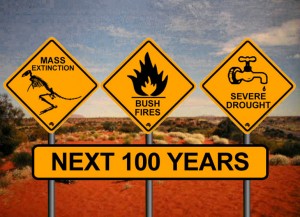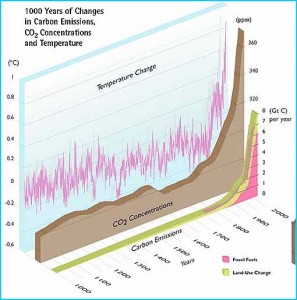The consequences of climate change have ceased to be subtle.
In the past decade alone, we have witnessed dramatic weather-related events that scientists tie back to the rising concentration of CO2 in our atmosphere:
- In 2003, an unprecedented heat wave swept through Europe, killing over 35,000 people with the highest temperatures in centuries.
- An “epic” 6-year drought has dried up the Murray-Darling Basin, which provides nearly 85% of the water used for agriculture in Australia, forcing the Prime Minster to declare a ban on irrigation this coming summer.
- The melting rate of Pine Island Glacier on the West Antarctic Ice sheet has increased from 2cm/year to 1.6m/year since 1990. The current melting rate is more than 20 times faster than the melting rate the glacier maintained over the past 45,000 years.

Temperature change over the past millenium
These events are not caused by natural fluctuations of the Earth’s climate. The global climate does fluctuate due to the output of volcanic gasses and slight shifts in the planet’s axis of rotation, but the changes we have witnessed in the past two centuries deviate significantly from the natural variations. The detailed records we have taken over the past 150 years of the Earth’s surface temperature provide us with a good selection of data for comparison. As the graph shows, around the year 1850, the date of the Industrial Revolution, the concentration of CO2 in the air begins to climb dramatically, quickly and far exceeding the range of natural fluctuations observed between the years 1000-1800. While the temperature swung back and forth, prior to the 1800s, it stayed within about 1°C. Between 1850 and today, the temperature has rocket up an additional 0.5°C.
Additional evidence:
- Because our global economy is so reliant upon fossil fuels, we have a comprehensive record of how much coal, oil, and other resources we have used since the 1800s, which we can compare to the amount of CO2 intensity in the atmosphere. The levels are remarkably well correlated.
- The type of CO2 in the atmosphere also indicates that fossil fuels are to blame for this dramatic increase in global temperature. The most common Carbon isotope in the atmosphere today is not radioactive Carbon-14, or Carbon-13, but Carbon-12 which is derived from dead organic matter. Since fossil fuels are composed of dead organic matter, we can infer that the high concentration of CO2 in our atmosphere is related to fossil fuel consumption and not natural sources like volcanic emissions or deep-sea Carbon release.
- In the lab, scientists can only re-create our current climate situation when they include anthropogenic factors in their climate model simulations. Natural factors alone do not produce the conditions we are witnessing today.
Though it is not in the nature of the scientific community to report anything as “certain” or “proven,” the credible research completed in the past decade clearly and unanimously indicates that global warming has been greatly accelerated by human activities.
But let us be frank: determining who is to blame is only important for convincing skeptics of the severity of the challenges at hand. The most important facts to consider are the consequences we face, and our ability (or inability) to deal with them. As Table 1 illustrates, we have two possible interpretations and two possible responses – four possible resulting scenarios. If we are wrong and climate change is nothing but a bad scare, the worst that will happen is that we devote a lot of time, stress, and money to developing new technologies and preserving the natural world. But if we are right and if we do nothing, the consequences will be swift, extensive, and dire indeed. Are we, the great shapers of our habitat, going to leave that up to chance?
Table 1.
|
Climate change is real |
Climate change is not real |
|
| We make changes to massively reduce our impact on the climate |
1. Climate change is real + We react |
2. Climate change is not real + We react |
| We do nothing, continuing with our current lifestyle |
3. Climate change is real + We do nothing |
4. Climate change is not real + We do nothing |
(Mann, Michael E., and Kump, Lee R. Dire Predictions: Understanding Global Warming. New York: Daniel Kaveney, 2009.)
Tags: Australia, climate change, Drought, fossil fuels, heat wave, human-induced